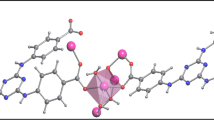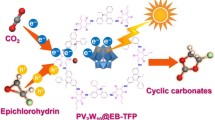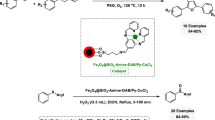Abstract
Four coordination polymers based on two bis-pyridyl-bis-amide ligands and three aromatic dicarboxylates with different substituent groups, namely, [Co(3-bpcb)1.5(NPH)(H2O)]·4H2O (1), [Co(3-bpcb)(NIPH)] (2), [Co(3-bpcb)0.5(5-H2AIP)]·2H2O (3), [Co(3-bpcd)0.5(5-H2AIP)(H2O)]·2H2O (4) [3-bpcb = N,N′-bis(3-pyridinecarboxamide)-1,4-benzene, 3-bpcd = N,N′-bis(3 pyridine)cyclohexane-1,4-dicarboxamide, H2NPH = 3-nitrophthalic acid, H2NIPH = 5-nitroisophthalic acid, 5-H4AIP = 5-aminoisophthalic acid] have been synthetized under hydrothermal conditions. Complex 1 displays a one dimensional (1D) chain based on the binuclear [Co2(NPH)2] units and 3-bpcb ligands, which is extended into a three dimensional (3D) supramolecular framework through hydrogen bonding and π-π stacking interactions. In complex 2, the (3,5)-connected two dimensional (2D) layers are constructed from 1D Co-NIPH chains and bidentate-bridging 3-bpcb ligands. Complex 3 is a 2D double layer based on Co-5-H2AIP 2D layers and 3-bpcb pillars. Complex 4 also displays a 2D network, which is constructed from the Co-5-H2AIP 1D double chains and 3-bpcd ligands. Finally, complexes 2-4 are extended into 3D supramolecular frameworks by hydrogen bonding or π-π stacking interactions. The substituent groups of dicarboxylates play an important role in the assembly and structures of the title complexes. In addition, the fluorescent properties of complexes 1–4 and the electrochemical behaviors of 3 and 4 at room temperature have been investigated.
Similar content being viewed by others
References
Lee CY, Bae YS, Jeong NC, Farha OK, Sarjeant AA, Stern CL, Nickias P, Snurr RQ, Hupp JT, Nguyen ST. Kinetic Separation of propene and propane in metal-organic frameworks: Controlling diffusion rates in plate-shaped crystals via tuning of pore apertures and crystallite aspect ratios. J Am Chem Soc, 2011, 133(14): 5228–5231
Pramanik S, Zheng C, Zhang X, Emge TJ, Li J. New microporous metal-organic framework demonstrating unique selectivity for detection of high explosives and aromatic compounds. J Am Chem Soc, 2011, 133(12): 4153–4155
Zeng YF, Hu X, Liu FC, Bu XH. Azido-mediated systems showing different magnetic behaviors. Chem Soc Rev, 2009, 38(12): 469–480
Bagai R, Christou G. The Drosophila of single-molecule magnetism: [Mn12O12(O2CR)16(H2O)4]. Chem Soc Rev, 2009, 38(4): 1011–1026
Herm ZR, Swisher JA, Smit B, Krishna R, Long JR. Metal-organic frameworks as adsorbents for hydrogen purification and precombustion carbon dioxide capture. J Am Chem Soc, 2011, 133(15): 5664–5667
Men YB, Sun JL, Huang ZT, Zheng QY. Rational construction of 2D and 3D borromean arrayed organic crystals by hydrogen-bond-di-rected self-assembly. Angew Chem Int Ed, 2009, 48(16): 2873–2876
Han ML, Wang JG, Ma LF, Guo H, Wang LY. Construction of Cd(II) coordination polymers based on R-isophthalate (R = -CH3 or -OCH3) and flexible N-donor co-ligands: Syntheses, structures and photolu minescence. CrystEngComm, 2012, 14(8): 2691–2701
Kundu N, Abtab SMT, Kundu S, Endo A, Teat SJ, Chaudhury M. Triple-stranded helicates of zinc(II) and cadmium(II) involving a new redox-active nultiring nitrogenous heterocyclic ligand: Synthesis, structure, and electrochemical and photophysical properties. Inorg Chem, 2012, 51(4): 2652–2661
Li GB, He JR, Pan M, Deng HY, Liu JM, Su CY. Construction of 0D to 3D cadmium complexes from different pyridyl diimide ligands. Dalton Trans, 2012, 41(15): 4626–4633
Yan Z, Li M, Gao HL, Huang XC, Li D. High-spin versus spin-crossover versus low-spin: geometry intervention in cooperativity in a 3D polymorphic iron(II)-tetrazole MOFs system. Chem Commun, 2012, 48(33): 3960–3962
Bittner MM, Baus JS, Lindeman SV, Fiedler AT. Synthesis and structural characterization of iron(II) complexes with tris(imidazolyl) phosphane ligands: a platform for modeling the 3-histidine facial triad of nonheme iron dioxygenases. Eur J Inorg Chem, 2012, 2012(11): 1848–1856
Song XZ, Song SY, Qin C, Su SQ, Zhao SN, Zhu M, Hao ZM, Zhang HJ. Syntheses, structures, and photoluminescent properties of coordination polymers based on 1,4-bis(imidazol-l-yl-methyl)benzene and various aromatic dicarboxylic acids. Cryst Growth Des, 2012, 12(1): 253–263
Colacio E, Perea-Buceta JE, Mota AJ, Brechin EK, Prescimone A, Hänninen M, Seppälä P, Sillanpää R. Touching the upper limit for ferromagnetic interactions in hetero-bridged dinuclear [Cu2 II] complexes using a novel N5-dinucleating ligand bearing an endogenous monoatomic amido(R-NH−)-bridging group. Chem Commun, 2012, 48(6): 805–807
Gass IA, Moubaraki B, Langley SK, Batten SR, Murray KS. A π-π 3D network of tetranuclear μ2/μ3-carbonato Dy(III) bis-pyrazolylpyridine clusters showing single molecule magnetism features. Chem Commun, 2012, 48(15): 2089–2091
Xiao J, Chen CX, Liu QK, Ma JP, Dong YB. Cd(II)-schiff-base metal- organic frameworks: synthesis, structure, and reversible adsorption and separation of volatile chlorocarbons. Cryst Growth Des, 2011, 11(12): 5696–5701
Banerjee S, Adarsh NN, Dastidar P. An unprecedented all helical 3D network and a rarely observed non-interpenetrated octahedral network in homochiral Cu(II) MOFs: effect of steric bulk and π-π stacking interactions of the ligand backbone. CrystEngComm, 2009, 11(5): 746–749
Adarsh NN, Kumar DK, Dastidar P. Ligating topology and counter anion controlled formation of discrete metallo-macrocycle and 2D corrugated sheet in coordination compounds derived from a bis-pyridyl-bis-amide ligand and Cd(II) salts. Inorg Chem Commun, 2008, 11(5): 636–642
Liu D, Chang YJ, Lang JP. Ligand geometry-driven formation of different coordination polymers from Zn(NO3)2, 1,4-bpeb and phenylenediacetic acids. CrystEngComm, 2011, 13(6): 1851–1857
Yamada T, Iwakiri S, Hara T, Kanaizuka K, Kurmoo M, Kitagawa H. Porous interpenetrating metal-organic frameworks with hierarchical nodes. Cryst Growth Des, 2011, 11(5): 1798–1806
Cheng JJ, Chang YT, Wu CJ, Hsu YF, Lin CH, Proserpio DM, Chen JD. Highly interpenetrated diamondoid nets of Zn(II) and Cd(II) coordination networks from mixed ligands. CrystEngComm, 2012, 14(2): 537–543
Adarsh NN, Sahoo P, Dastidar P. Is a crystal engineering approach useful in designing metallogels? A case study. Cryst Growth Des, 2010, 10(11): 4976–4986
Gong Y, Li J, Qin JB, Wu T, Cao R, Li JH. Metal(II) coordination polymers derived from bis-pyridyl-bis-amide ligands and carboxylates: syntheses, topological structures, and photoluminescence properties. Cryst Growth Des, 2011, 11(5): 1662–1674
Wang XL, Mu B, Lin HY, Liu GC. Three new two-dimensional metal-organic coordination polymers derived from bis(pyridinecarboxamide)- 1,4-benzene ligands and 1,3-benzenedicarboxylate: Syntheses and electrochemical property. J Organomet Chem, 2011, 696(11–12): 2313–2321
Wang XL, Lin HY, Mu B, Tian AX, Liu GC. Encapsulation of discrete (H2O)12 clusters in a 3-D three-fold interpenetrating metal-organic framework host with (3,4)-connected topology. Dalton Trans, 2010, 39(27): 6187–6189
Wang S, Bai JF, Xing H, Li YZ, Song Y, Pan Y, Scheer MF, You XZ. Novel alternating ferro-ferromagnetic two-Dimensional (4,4) and photoluminescent three-dimensional interpenetrating PtS-type coordination networks constructed from a new flexible tripodal ligand as a four-connected node. Cryst Growth Des, 2007, 7(4): 747–754
Wang XL, Bi YF, Liu GC, Lin HY, Hu TL, Bu XH. Zn(II) coordination architectures with mixed ligands of dipyrido[3,2-d:2′,3′-f] quinoxaline/2,3-di-2-pyridylquinoxaline and benzenedicarboxylate: syntheses, crystal structures, and photoluminescence properties. CrystEngCommun, 2008, 10(3): 349–356
Li XJ, Cao R, Bi WH, Wang YQ, Wang YL, Li X, Guo ZG. A new family of cadmium(II) coordination polymers from coligands: effect of the coexistent groups (R = H, −NO2, −OH) on crystal structures and properties. Cryst Growth Des, 2005, 5(4): 1651–1656
Luo JH, Hong MC, Wang RH, Cao R, Han L, Yuan DQ, Lin ZZ, Zhou YF. A novel bilayer cobalt(II)-organic framework with nanoscale channels accommodating large organic molecules. Inorg Chem, 2003, 42(15): 4486–4488
Wang HN, Meng X, Qin C, Wang XL, Yang GS, Su ZM. A series of pillar-layer metal-organic frameworks based on 5-aminoisophthalic acid and 4,4′-bipyridine. Dalton Trans, 2012, 41(3): 1047–1053
Gao Q, Wu MY, Huang YG, Chen L, Wei W, Zhang QF, Jiang FL, Hong MC. Double-walled tubular metal-organic frameworks constructed from bi-strand helices. CrystEngComm, 2009, 11(9): 1831–1833
Wang HN, Meng X, Wang XL, Yang GS, Su ZM. Auxiliary ligand induced structural allomorphism in nanotubular microporous metalorganic frameworks based on discrete magnesium clusters. Dalton Trans, 2012, 41(8): 2231–2233
Qiu YC, Deng H, Yang SH, Mou JX, Daiguebonne C, Kerbellec N, Guillou O, Batten SR. Syntheses, crystal structures, and gas storage studies in new three-dimensional 5-aminoisophthalate praseodymium polymeric complexes. Inorg Chem, 2009, 48(9): 3976–3981
Zeng MH, Zou HH, Hu S, Zhou YL, Du M, Sun HL. Unique (3,13)-connected coordination framework based on pentacobalt clusters constructed from the (3,12)-connected analogue and 4,4′-bipyridyl spacer: structural and magnetic aspects. Cryst Growth Des, 2009, 9(10): 4239–4242
Sarkar M, Biradha K. Amide-to-amide hydrogen bonds in the presence of a pyridine functionality: crystal structures of bis(pyridinecarboxamido)alkanes. Cryst Growth Des, 2006, 6(1): 202–208
Li L, Song YL, Hou HW, Liu ZS, Fan YT, Zhu Y. Self-assembly and third-order optical properties of HgI2 with linear and angular bipyridine ligands. Inorg Chim Acta, 2005, 358(11): 3259–3266
Sheldrick GM. SHELXS-97, Program for the Solution of Crystal Structure. University of Göttingen, Göttingen, Germany, 1997
Sheldrick GM. SHELXL-97, Program for the Refinement of Crystal Structure, University of Göttingen, Göttingen, Germany, 1997
Li CP, Chen J, Yu Q, Du M. Structural modulation and properties of silver(I) coordination frameworks with benzenedicarboxyl tectons and trans-1-(2-pyridyl)-2-(4-pyridyl)ethylene spacer. Cryst Growth Des, 2010, 10(4): 1623–1632
Su Z, Xu J, Fan J, Liu DJ, Chu Q, Chen MS, Chen SS, Liu GX, Wang XF, Sun WY. Synthesis, crystal structure, and photoluminescence of coordination polymers with mixed ligands and diverse topologies. Cryst Growth Des, 2009, 9(6): 2801–2811
Allendorf MD, Bauer CA, Bhakta RK, Houk RJT. Luminescent metal-organic frameworks. Chem Soc Rev, 2009, 38(5): 1330–1352
Meng R, Weber SG. The rotating ring-disk electrochemistry of the copper(II) complex of thyrotropin-releasing hormone. J Electroanal Chem, 2007, 600(2): 325–334
Cowan MG, Brooker S. Nine non-symmetric pyrazine-pyridine imide-based complexes: reversible redox and isolation of [MII/III(pypzca)2]0/+ when M = Co, Fe. Dalton Trans, 2012, 41(5): 1465–1474
Author information
Authors and Affiliations
Electronic supplementary material
Rights and permissions
About this article
Cite this article
Wang, X., Mu, B., Lin, H. et al. Substituent groups from aromatic dicarboxylates modulated structural diversification in the assembly of Co(II) complexes based on the bis-pyridyl-bis-amide ligands. Sci. China Chem. 56, 557–566 (2013). https://doi.org/10.1007/s11426-012-4784-6
Received:
Accepted:
Published:
Issue Date:
DOI: https://doi.org/10.1007/s11426-012-4784-6




